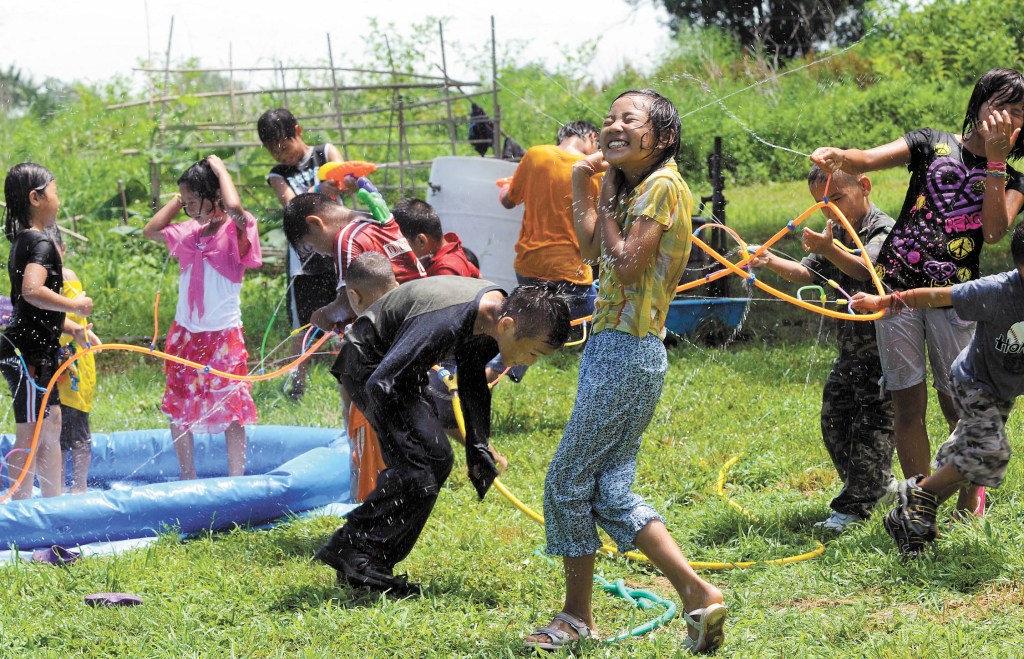Many new faces make city a melting pot
Published 1:44 pm Friday, September 14, 2012

- Children play in the water as part of the water throwing ceremony at the Burma's Water and New Year Festival in 2010 at the Buddhist International Temple. (Miranda Pederson/Daily News)
Future historians who will look back on present-day Bowling Green years from now might point to 1979 as the year that the city opened itself up to the world.
That was the year the International Center of Bowling Green was established.
Trending
The nonprofit organization has resettled thousands of refugees from war-torn and politically unstable nations around the world. Since resettling the first wave of refugees from Vietnam, Cambodia and Laos in the late 1970s and early ’80s, the center has brought a visible changing to the city’s complexion and a broadening of its cultural options to the extent that Bowling Green’s minority population is unlike that of many other American cities its size.
Its first executive director, Marty Deputy, came aboard when the city’s economic and transportation infrastructure first seemed poised to accommodate foreign-born populations.
Deputy’s sensibility proved to be the ideal fit for leading the international center, as she and the case workers there worked to help refugees go through the complicated process of assimilating in a new, unfamiliar environment.
“We were always taught that we were the same as anybody else,” Deputy said of her upbringing in the Beech Bend area.
In the succeeding years, Bowling Green would become the new home for resettled refugees from the old Soviet republics in the late 1980s and early ’90s, many refugees from Bosnia beginning in 1993 and small numbers of Burundi, Iraqi, Somalian, Burmese, Liberian, Cuban and other refugees in the current millennium.
“I think it’s, hopefully, opened up some people to other cultures and languages,” said Deputy, who retired six years ago.
Trending
Bowling Green’s diverse international population is a recent phenomenon, although foreign-born residents do show up before 1979.
The 1860 census listed a population that included 447 foreign-born residents in Warren County, which had a population that year of 17,320.
The demographics of the foreign-born population reflect immigration patterns of the time, with a majority of Bowling Green’s foreign-born population – 245 people – hailing from Ireland, not a surprise given the exodus of Irish during the second half of the 19th century to the United States in the wake of the potato famine in their native land.
Another 108 foreign-born residents in 1860 were from Germany, with the remaining population being represented by England, Scotland, France, Italy and Switzerland.
Between 1860 and 1910, the local foreign-born population fluctuated, reaching a peak of 774 residents in 1900.
Jonathan Jeffrey, manuscripts/folklife archives coordinator at the Kentucky Library at Western Kentucky University, said the prevalence of housing and employment in the Northeast and industrial Midwest for new immigrants tended to stop larger numbers of European immigrants from moving further inland once they reached the U.S.
African-Americans have represented the most statistically significant minority in Bowling Green over the years.
“The 1810 census taker counted 11,937 Warren (County) residents, 1,498 of whom were slaves and 17 ‘free persons of color,’ ” according to “Bowling Green and Warren County: A Bicentennial History,” written in 1999 by Nancy Baird, a Kentucky history specialist now retired from the Kentucky Library, and WKU history professor Carol Carraco.
Immigration dropped off significantly after World War I, and population totals reflect a decline in Bowling Green’s foreign population. By 1930, the U.S. census showed just 80 foreign-born Warren County residents, and 62 people living in Bowling Green were born outside the U.S.
Ten years earlier, Bowling Green had just 85 foreign-born citizens, according to census data, even as the city’s overall population increased by 2,710 people from 1920 to 1930.
In that same time period, the city’s black population increased, but represented a smaller percentage of Bowling Green’s overall population in 1930 than in 1920.
“I would say there’s a big drop during the Depression era because Caucasians as well as African-Americans left the area to go to the Midwest for more social opportunities and civil freedom,” Jeffrey said.
Noteworthy immigrants from the early 20th century are few and far between, although Bowling Green did have a small but influential Greek population that included Spero Kereiakes, the dentist and former mayor who helped develop the park named for him.
Also, history records a Chinese immigrant who owned a laundry business here in the late 19th century.
“The only reason we know about him at all was because he was murdered and apparently the case was never solved,” said Jeffrey, adding that the business owner is buried in an unmarked grave at Fairview Cemetery.
From minuscule numbers, the city’s population of foreign nationals has risen to represent 10.9 percent of the total population of 58,067 counted in the 2010 census. Data from the census bureau shows that 6.5 percent of the population is of Hispanic or Latino origin.
Deputy maintains warm relations with many of the families she helped resettle years ago, including Vietnamese families who have raised children here.
Resettlement is a complex process that is shepherded by the U.S. State Department, which determines the number of refugees each participating city receives each year.
Refugees also strike a delicate balance between adjusting to life in a new country and remembering the heritage of their native lands.
The Bowling Green International Festival has grown with the refugee community over the past decade as an annual celebration of the cultures of many nations.
The International Center has fostered a network of sorts with other local agencies to help newly resettled refugees learn English, find employment or enroll in school, be placed in housing and obtain access to social services.
“You just have to open doors for people and they will become very self-sufficient,” Deputy said. “Your basic things are to still help people help themselves and empower them to not need your help later.”
Linda McCray, executive director of the Bowling Green Human Rights Commission, has seen her agency make inroads with the city’s immigrant communities, often holding educational workshops in churches where immigrants worship and informing them about how to avoid discrimination in housing and other areas of life.
“We plan events with faith-based communities to enable us to reach these particular populations,” McCray said. “We do a lot of outreach to children. Many of the immigrants who live in Bowling Green now who have English as a second language, sometimes the best way to reach them is through their children, who often speak English right away.”
Both the city and county public school systems have well-established English as a second language programs.
In March 2011, there were 507 ESL students in Bowling Green Independent Schools, of whom 328 spoke Spanish as their first language, while more than 40 languages are spoken among the students in Warren County Public Schools, which opened its Gateway to Educational Opportunities Center last year.
The GEO Center helps new international students and their families through the enrollment process, assesses students’ proficiency in English and assists families in working through issues such as transportation and language barriers.
Suzanne Rose, who became interim director of the International Center last month, said the concerns of each of the refugee and immigrant communities from around the world vary, although the language barrier is a universal one for the newly resettled to move past.
About 350 new refugees are anticipated to be resettled in Bowling Green next year, remaining fairly consistent with previous years that have seen the number of new refugees generally hover between that total and 450, Rose said.
The population of Burmese refugees has grown in recent years, despite an initial influx of Burmese dispersing from Bowling Green soon after arriving here in 2000 and 2001 to cities such as Indianapolis.
One of the original group of Burmese refugees would return to Bowling Green, and she now works as a case manager at the International Center, Rose said.
“I think it will be a different experience for younger refugees getting used to growing up in a more global village than I grew up in,” said Rose, who helped establish a satellite office of the International Center in Owensboro three years ago.
“The process by which refugees are heavily vetted is the same for the communities to which they’re sent,” Rose said. “If a community is chosen to resettle refugees, that’s a real star for the city. It means they are a thriving, caring community, and I think it’s something of which to be proud.”






